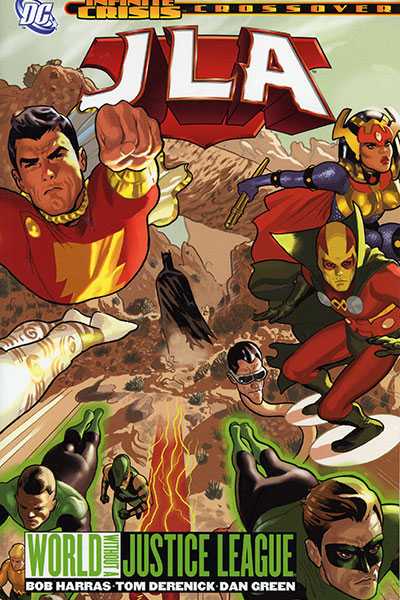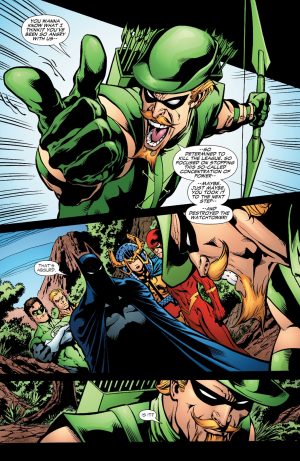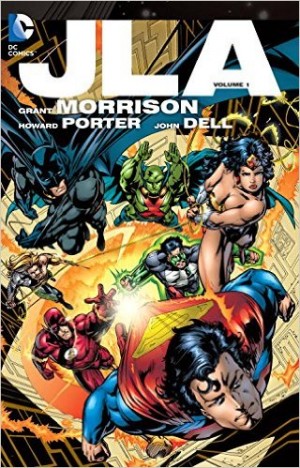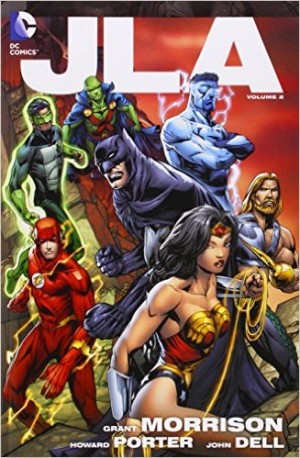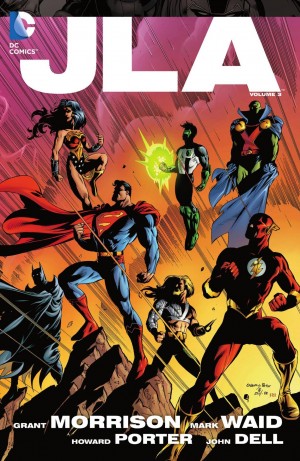Review by Karl Verhoven
In 2004 the big Justice League plot was the revelation that in the past some League members had resorted to mindwiping villains in order to remove their antisocial tendencies. It led to problems throughout the DC universe, beginning with Identity Crisis, and the most immediate consequence here is that the schisms within the team have led the JLA to disband.
In an opening episode intended to draw a line under this incarnation of the Justice League, Bob Harras lays out clearly enough what’s to follow. Both he and artist Tom Derenick ramp up every emotion to the max as the league members bicker among themselves in what’s meant to be a spiritual ceremony marking the end of an era. Batman’s self-righteousness is the cause of much animosity. “You’re going to be the one to watch?”, asks Aquaman, “You’re going to decide when we stepped out of line?”, while Green Arrow can’t manage better than the playground accusation of “Who appointed you God of Us? Of everyone!”. It’s uncomfortable reading, not because it’s meant to be, but because it’s so shabbily handled. Melodrama has long been part of superhero comics, but this is the contrived style of the poorest soap operas. Derenick doesn’t help by drawing everyone with mouths wide open or grim-faced in exaggerated poses.
Having disbanded the team, Aquaman and several others consider it might be a good idea to have a loose alliance of superheroes who can come together in times of need to protect humanity. Hmmm, sounds like the Justice League in all but name. And, hey, they could operate from the League’s old cave headquarters, and look, Aquaman’s managed to download all the old League’s computer files. What Harras does do is activate some Justice League members unseen for a while, like Red Tornado, and have Supergirl replace Superman, and then the supposedly dead Donna Troy turns up to siphon off a few members for an urgent mission in space. Yes, it’s meant to set up events in Infinite Crisis, but it’s all so clumsy and obvious except for the moments such as Donna Troy’s few pages, which come across as a space filling interlude as they go nowhere. Harras also features an almost histrionic villain, ridiculously drawn and constantly monologuing portentous garbage, their identity kept concealed until the halfway point, but because it suits the story they have previously unknown telepathic powers. What that’s used to set up is a good idea, but not well played out as it’s as overblown as everything else. That equally applies to the wrap up of Manitou Dawn’s story, which is intended as a heart-wrenching exploration of a young woman struggling to find their way after a couple of major setbacks. Instead it has the emotional depth of a brick in the face.
This volume concludes the JLA series relaunched so brilliantly by Grant Morrison in 1997, following the earlier franchise running out of ideas. It was a long, slow decline, and based on the work of Harras and Derenick, a world without a Justice League seems a very good idea. It leads into Infinite Crisis, and then another relaunch, this time under Brad Meltzer.
